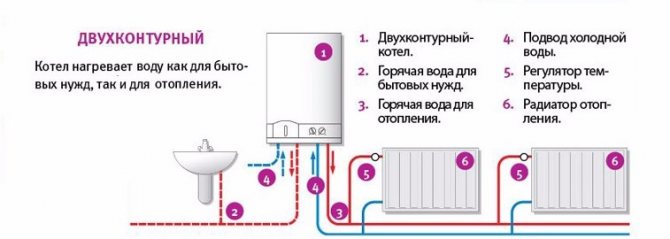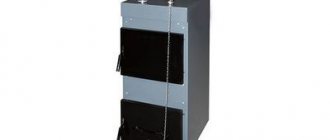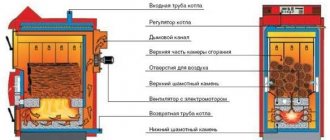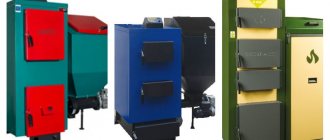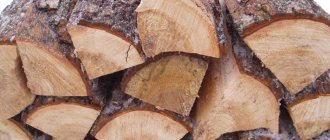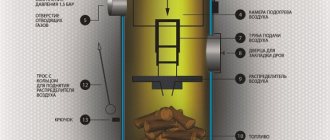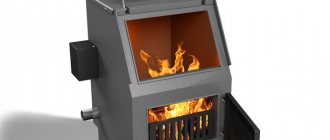How justified is a double-circuit solid fuel boiler in a private house
Departure for permanent residence from the city to nature in a private house will inevitably pose two extremely important problems for a modern person: reliable and comfortable heating and a sufficient amount of hot water. It is not uncommon for one more circuit to be added to heating - a warm floor. It is possible to organize all three circuits: heating, hot water supply and underfloor heating are completely autonomous from each other, but equipment with control and piping can take up a significant part of the living space and reduce the reliability of the system, not to mention the higher cost and installation costs.
A double-circuit wood-burning boiler can solve these problems. For those who want to gain independence from expensive gas and reduce electricity consumption, there are many double-circuit solid fuel boilers on the market. Despite the fact that they are more expensive than single-circuit ones (sometimes the price is 30% higher), this is the most budgetary way to organize hot water supply. The correct choice of the boiler will allow you to create a simple, reliable, and with the availability of inexpensive fuel, an economically viable system.
The cost of a low-power solid fuel boiler of 10 kW with two circuits starts from 19,000-20,000 rubles. Higher power models that use different types of fuel, as well as different combustion principles and additional options will cost the buyer 100,000 rubles.
The use of double-circuit solid fuel boilers provides the following possibilities:
- complete independence from gasification and power grids (if the boiler unit is non-volatile or alternative sources of electricity are used);
- real economy due to the relatively high efficiency and the use of affordable inexpensive fuel (wood and its waste, coal, peat).
- ease of maintenance, especially for inexpensive systems without automatic fuel supply;
- reliability and long-term use when properly installed and operated.
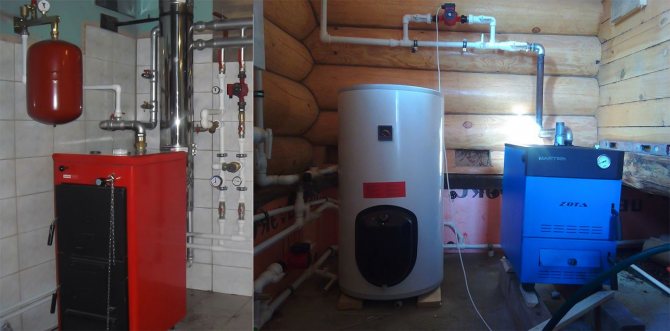
On the left is a double-circuit solid fuel boiler. On the right is a single-circuit one with an indirect heating boiler. In the first case, significant savings not only on equipment, but also on the strapping, significant savings in space.
But there are also many disadvantages of systems using solid fuel boilers:
- the need to store fuel in stock without getting wet and provide additional meters in the boiler room for loading;
- the need for inexpensive boilers to load fuel manually. Automatic loading, which allows the boiler to operate for several days, is a rare and expensive option that reduces the reliability of the system;
- careful attention to the quality of fuel takes time;
- regular cleaning of ash, cleaning of carbon deposits and inspection of the chimney.
How to increase productivity
When purchasing and installing a solid fuel boiler, a prudent owner thinks about how to increase its service life. And this is correct, since in such a unit there are a number of techniques, adhering to which you can get the maximum efficiency.
The first advice given by experts is to choose the type of fuel professionally in order to increase productivity. The second advice also applies to fuel, it must be of good quality, for example, you cannot throw raw firewood or coal into the furnace. The third tip is to optimize the heating system in the house as much as possible by applying modern options, for example, with collector wiring of the coolant. The fourth tip is to provide reliable thermal insulation in the house.
If all the tips by the owner are followed, then the solid fuel boiler will be able to compete with gas and electric units.
https://youtu.be/o4ggwOFtDwY
Device and principle of operation
Fundamentally, two-circuit models differ little from classic solid-fuel single-circuit boilers. The only difference is the presence of an additional DHW circuit, in which sanitary water does not mix with technical water in the heating circuit. The second circuit can be organized in different ways, previously the water jacket was simply divided into two parts.
A more advanced option is to place a coil of pipes for the second hot water supply circuit inside the water jacket with the coolant of the first heating circuit. This interaction of the circuits protects the DHW coil tube from overheating, and they work longer without forming scale inside themselves.


The device of a double-circuit solid fuel boiler on the example of the Wirbel ECO SKB model with a built-in storage tank.
Now the most common are DHW circuits heated by heating elements (tubular electric heaters). In heating mode, the boiler works like the most ordinary classic non-volatile solid fuel, but if you need to heat up the DHW circuit, there is a built-in replaceable block of heating elements, usually with a capacity of 3-9 kW. Otherwise, there are no differences from the classic boiler known to all TT.
Long-burning double-circuit solid fuel boilers
Thanks to the shaft-type chamber and combustion from top to bottom, it is possible to achieve combustion of one fuel load for up to 24 hours or even 7 days. However, it is difficult to make such a double-circuit design, and its cost will be comparable to two separate, often more reliable, solid fuel boilers. Therefore, despite the demand, today there are no two-circuit solid-fuel models for long-term combustion; even local little-known manufacturers are not engaged in the production of such models. Nevertheless, if you managed to find long-burning two-circuit models, please let us know in the comments.
Unit design
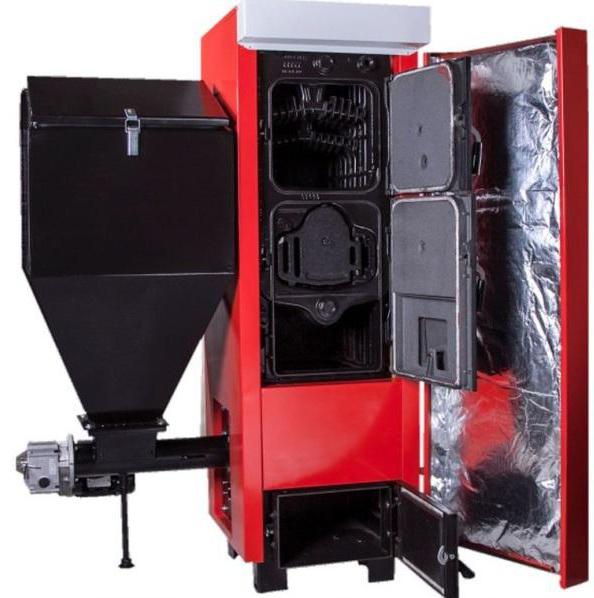

The design is based on the combustion chamber. It receives fuel, after which it acts as a source of heat to be distributed. The circulation of heat flows is divided into two circuits, one of which is aimed at serving water, and the second is exclusively for the function of heating the premises. But the features of the two-circuit system as such will be discussed later. In addition to the circuits and the combustion chamber, a double-circuit solid fuel boiler provides for an ash pan, a switching damper, a draft regulator, a telescopic pipe and an air heating chamber. Depending on the modification, the design can be improved by optional inclusions - for example, a fuel delivery module, a hob, etc.
Fuel options
The fuels used in solid fuel boilers are:
- firewood and wood processing waste (wood chips, sawdust, pellets - pressed sawdust);
- coal and brown coal (however, be careful, not all combustion chambers are designed for high temperature of coal combustion);
- fuel briquettes;
- peat.
Some of the equipment runs on only one fuel (wood or coal), most use any solid fuel, but there are boilers with additional accessories or the possibility of retrofitting a burner, which makes it possible to use liquid fuel in them, if necessary.
It is necessary to clearly understand that the rated power of the boiler depends on the calorific value and quality of various fuels. The maximum boiler output is indicated for certain characteristics of the fuel under optimal operating conditions. Using raw wood or pellets can result in a 30% loss of power, accelerated ash and varnish formation, which will shorten the life of the unit.
Inexpensive solid fuel boilers are almost omnivorous, as long as the fuel is dry, but with the growing desire for automation, the importance of pellets increases. They have a number of advantages:
- it is convenient to load into the furnace manually and automatically from the hopper with a screw;
- easy to organize storage;
- the release of about 5 kW of thermal energy from 1 kg;
- the use of low ash pellets reduces the amount of ash.
The use of coal and brown coal for fuel is justified in places where they are readily available and affordable.
Pellet boilers with automatic fuel supply Burn time from 7 to 30 days thanks to the storage bunker
Types of boilers according to the combustion principle
Solid fuel boilers can have heating surfaces made of cast iron or steel. Cast iron boilers are more expensive, but have a longer service life due to their anti-corrosion and heat-resistant qualities.
Steel structures are cheaper. The thickness of the sheet steel depends on the boiler output. For units with a small heating capacity up to 12 kW, it is allowed to use sheet steel of at least 3.0 mm. For boilers over 12 kW - thicker steel.
According to the principle of combustion, boilers differ in furnaces with natural and forced circulation of gas-air masses. In the first modification, the devices operate on natural draft, and the combustion process is controlled by a thermostatic regulator.
In this case, flue gases are discharged into the chimney without forced air intake into the furnace. The second models are equipped with a special blower fan that supplies air to the combustion space and is responsible for the aerodynamic parameters of the movement of gas-air flows in the firebox and flue ducts.
Gas generating
Pyrolysis is the combustion of solid fuels with an oxygen deficiency. In the process of underburning, a solid residue in the form of ash will be created, and the combustible pyrolysis gas in the form of a mixture of carbon dioxide and volatile hydrocarbons completely burns out, releasing thermal energy.


The gas generating process can be divided into two stages:
- Slow fuel smoldering with oxygen deficiency. The air supply is limited by a simple mechanical damper. If the heat generation process needs to be increased, then this can be done using a forced pressurization system - a blower fan.
- In the secondary combustion chamber, volatile substances formed as a result of the thermal decomposition of the fuel are burned. This process is also easily controlled using a simpler thermostat that allows the boiler to produce the required amount of heat energy.
Top burning
This modification of boilers refers to solid fuel heating devices for long burning. They are capable of working for as long as possible on one tab, compared to other modifications of solid fuel boilers.
Basic structural components of top combustion devices:
- The bottom blind pan for placing fuel, in this zone, the combustion process is not permissible.
- Cylindrical firebox. The air supply is top, in the center, which guarantees combustion of the upper fuel layer.
- The air supply distributor in the firebox can be moved, it rests directly on the fuel and descends according to the degree of its burnout.
- In the air supply zone, only partial oxidation of hydrocarbons is carried out. Volatiles enter the upper part of the combustion device, separated from the primary combustion zone by a thick steel disc.
- In the secondary chamber, oxygen from the atmospheric air is added to the pyrolysis gas, the volatiles completely burn out, giving up their heat to the heating medium circulating through the heat exchanger.


Units with an upper combustion chamber
In the chamber, where volatile substances burn, there is an automatic draft regulator - which regulates the speed of the flue gases, depending on the temperature of the coolant.
Reviews of solid fuel double-circuit boilers: advantages and disadvantages
| Benefits | disadvantages |
| This is the most budgetary option for organizing hot water supply in the house. | Fuel loading in inexpensive boilers is done manually and often, if it is necessary to heat the second circuit, the fuel consumption increases |
| High efficiency and low fuel cost compared to gas and electricity makes the economy of use profitable | Creation of a warehouse for fuel supplies, at least under a canopy or tarpaulin. |
| Most models do not need complex maintenance | Cleaning of spools and ash removal - the main work is performed manually on most boilers. |
| The transition from one solid fuel to another is cost-free | Periodic inspection of the chimney, pipes and fittings. |
| Without using the second circuit, these are classic, equally effective TT boilers | Limited choice of double-circuit TT models on the Russian market |
Features of the operation of double-circuit boilers
Solid fuel equipment was originally designed to maximize the amount of heat and hot water. Therefore, the work of the first circuit is aimed at heating the room, and the second at hot water supply.
When choosing it, you need to pay attention to the stability of the temperature regime. For example, a combined solid fuel boiler with electric heating, operating on the principle of an instantaneous water heater, cannot always avoid drops in the treated water.


Among the advantages of solid-fuel double-circuit devices should be highlighted:
- Ease of installation and operation
- Low cost of fuel and its availability
- Profitability
- Reliability
However, combined solid fuel heating boilers have their own disadvantages, such as:
- The need for manual fuel loading
- Mandatory boiler room equipment
- Pre-drying firewood
There is one more drawback of such equipment - it is the impossibility of precise regulation of water heating. Therefore, very often, indirect heating boilers are used in tandem with such a boiler.
What to look for when choosing
Before choosing a boiler model, decide for yourself the questions:
- Boiler for permanent residence, summer cottages or heating reserve.
- Type of solid fuel in terms of availability and cost.
- Number of circuits (heating, water heating, underfloor heating)
- The minimum required power of thermal energy (1 kW per 10 m2 of heated area + 20-25% of the reserve, the number of liters of hot water per minute).
- The heat exchanger is cast-iron or steel (cast-iron keeps heat longer, is resistant to inevitable corrosion and serves for a long time, steel heats up faster, but can burn out).
- What is the efficiency (high - pyrolysis combustion boiler, low - classic).
- How often you are ready to load fuel.
- Do you need dependence on electricity (ignition and fuel supply by automation).
- Fuel storage capacity and storage quality.
- The budget that you are ready to spend on the purchase and installation of equipment.
Boilers with a burning time of one fuel tab up to 7 days
Output
The options for long-term burning equipment considered above have both positive and negative technical characteristics, therefore, when choosing for a house, this must be taken into account. We recommend giving preference to models for which there is an abundance of fuel in a given area (see also the article “Infrared heating using various equipment”).
The video in the article will help you find additional information on this topic.
Did you like the article? Subscribe to our channel Yandex.Zen
The best known manufacturers and models: characteristics and prices
Karakan 16TPEV 3 16kW
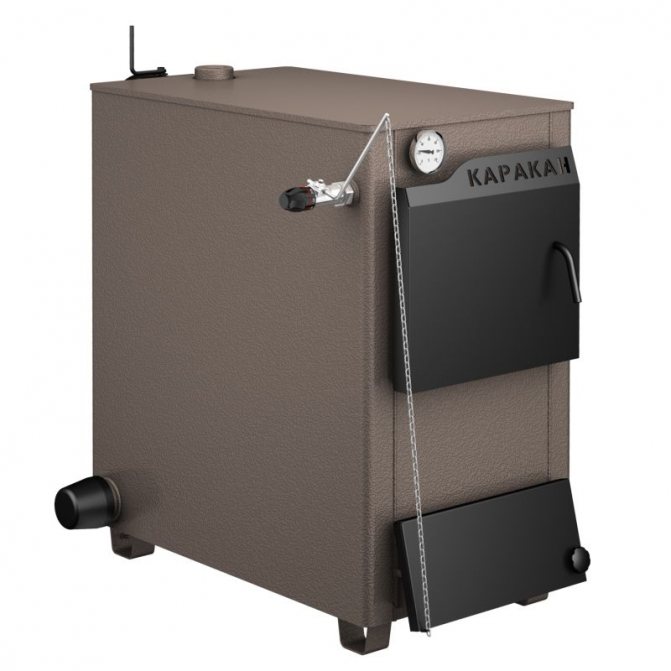

A popular in the countryside, a double-circuit boiler that uses any solid fuel. First of all, it gained popularity due to the deep firebox, which allows you to use firewood up to 50 cm long and the hob. For boilers of classic combustion, it has a sufficient efficiency of 75%, hot water produces 250 l / h. Preparation of sanitary hot water is carried out using a built-in heating element with a capacity of 9 kW. When operating for heating, the boiler is absolutely non-volatile, mechanically controlled by a thermostat. The unit weighs 120 kg.
Cost: RUB 25,000-27,000
Dragon Ta-15 Gv


One of the best double-circuit solid fuel boilers for heating a private house. A more advanced, efficient, practical and maintenance-friendly, but also a much more expensive boiler. The efficiency reaches 88%, it was achieved by the construction of a combustion chamber with a longer exhaust of gases, due to which more heat is accumulated by the heat exchanger. Also, of the features, it is worth noting the considerable volume of the firebox - 60 liters, the manufacturer claims 6-10 hours of burning one bookmark. In practice, this is true, but when using coal with a low ash content as a fuel.
The design of the door provides for the installation of an oil burner, but we recommend doing this only as a last resort: the efficiency of burning gas, diesel fuel or working out in a large combustion chamber of a solid fuel boiler will be extremely low. Owners also note the cast iron grate. The only drawback is the extremely high price.
Cost: RUB 53,500-62,000
Wirbel ECO CKB 20


Development of Austria, production usually in the Russian Federation. An even more advanced model with a complex exhaust of gases, due to which more heat is accumulated. The main serious difference is the organization of the second circuit by means of a storage boiler of 65 liters or more built into the main circuit, which allows you to always have a certain supply of hot water in stock, but reduces efficiency if the boiler is used only for heating the house. It is also worth noting the reliability of a heat exchanger made of 5 mm thick furnace steel; in practice, in other models, such heat exchangers serve for more than 15-17 years.
The only drawbacks are the high price and low prevalence, the boiler is quite difficult to find on sale in the territory of the Russian Federation.
Cost: RUB 63,000-66,000
Traian T-15-2KT


The boiler is completely Russian production, it differs only in a large combustion chamber of 80 liters, into which logs up to 55 cm are placed, which is extremely practical. At the same time, it has an extremely compact size. As for the rest, it is not as efficient and technologically advanced as the models mentioned above; it loses to its counterparts in terms of a set of parameters. Despite the existing demand and the prevalence of the model, in our opinion, its prices are too high.
Cost: RUB 47,000-58,000
The rating on the Internet is relative, but a comparison of features and prices gives an idea of the models and manufacturers.
How to choose
The purchase can be made in heating equipment stores or in specialized stores - in the latter case, the chances of buying a good double-circuit boiler with suitable characteristics increase significantly.
Fuel types


When choosing a model by type of fuel, think about how you will store this fuel. After all, each individual species requires certain conditions for storage.
Double-circuit solid fuel boilers for heating a private house can operate on a variety of fuels. The most popular type of fuel is ordinary firewood. In the southern regions, 13-14 cubic meters of oak, beech and hornbeam firewood cost about 14-17 thousand rubles, but you can find it cheaper. If possible, firewood can be bought cheaply from a local forester - this is often used by residents of small towns, villages and villages.
Firewood has a good heat release, and if it is obtained in the nearest forest, then it will also be free - the main thing is to manage to make a normal supply for the whole winter and allocate a place for their storage. And this becomes the main problem, because the wood is quite voluminous. And it still needs to be dried in order to improve combustion. For example, pyrolysis double-circuit solid fuel boilers need fuel with a moisture level of no more than 20-25%.
Pellets for pellet double-circuit boilers are quite an interesting and cheap type of fuel. One ton of pellets can be purchased for about 7,000 rubles. They can be easily stored in silos or in the nearest corner. Their advantages:
- Convenience of bookmarking - loose pellets can be poured into the chamber or into the bunker directly from the bag or with a spatula;
- Good heat dissipation - 5 kW per 1 kg of pellets;
- Low ash formation - true for special low ash pellets.
Thus, pellets can easily replace firewood.
Stone and brown corner can be used in almost any solid fuel boilers. But it is still preferable to use coal (black), since it burns for a long time and with a large release of heat - brown coal is picky about storage conditions and burns too quickly.
In terms of ease of use, pellets win - they contain a large amount of thermal energy, they are easy to store and very convenient to fill.
Heat exchanger material


Choose a unit with a cast iron heat exchanger, it will serve you much longer.
Let's say right away that preference should be given to models with cast-iron heat exchangers. Cast iron is an ideal material for such purposes - it easily withstands temperature overload, is resistant to corrosion, and is characterized by a long service life. And also it heats up quickly and cools slowly, continuing to give the accumulated heat to the heating system even in the absence of a flame.
A serious disadvantage of cast iron is its fragility. It cannot withstand shocks, so care must be taken when installing the equipment. The brittleness of this alloy increases with heating.
Steel heat exchangers are good because they can easily withstand water shocks, and double-circuit solid fuel boilers built on their basis are cheap. Among the disadvantages is the tendency to form corrosion and scale. But such boilers are easier to install, since they are very light - cast iron is a very heavy alloy.
Combustion principle
Long-burning double-circuit solid fuel boilers are divided into three categories:
- Pellet, with automatic fuel supply;
- Classic, with a large loading chamber;
- Pyrolysis, with combustion of wood (pyrolysis) gas.


If you do not have time to frequently throw up fuel, take a closer look at pellet boilers with a large bunker.
Pellet models can burn for a very long time - some models are endowed with giant bunkers that can hold up to several tens, or even hundreds of kilograms of granular fuel. The supply of pellets to the furnace is automatic... Separate units are even able to regulate combustion and are even equipped with automatic ignition systems.
Classic solid fuel boilers burn wood and coal in the traditional way. The frequency of the bookmark is 1 time in 3-5 hours. On sale there are modifications of long-term combustion, including double-circuit ones, with volumetric combustion chambers. They contain a large amount of fuel, which can burn up to 8-12 hours (the duration of combustion for some models is up to 24 hours).
Pyrolysis units are designed according to the principle of a gas generator. They burn wood in a primary chamber with little oxygen. The resulting wood gas is sent to the afterburner, where it is burned to generate a large amount of heat.Part of the thermal energy is sent to the first chamber, contributing to a more intense gas generation. Such boilers can burn from one tab for a very long time.
Criterias of choice
Despite the large assortment of manufactured models, it is not difficult to choose a boiler with a DHW circuit for your home. Should be considered a few main featuresthat are related to the operation and configuration of the equipment:
- The presence of an installed heating element - an additional heating device as a spare heat source. After fuel combustion, the heat carrier cools over time. A special sensor is mounted on the return line, which fixes the changes, it is connected to the heating element. After cooling the liquid below the set temperature, the heating element is automatically turned on, and the required temperature indicator of water heating is maintained. When the boiler is re-heated, the heating element is automatically switched off.
- Heat exchanger type. Cast iron and steel equipment is offered. The latter option is about two times cheaper, has a low weight and good resistance to temperature differences on the supply and return coolant circuits. The disadvantages include a relatively short operating time, no more than 20 years. The minimum operating time for cast iron equipment is 50 years. Cast iron models are characterized by high thermal performance, in contrast to steel devices.
In addition to the above characteristics, when choosing a boiler, you need to calculate the power, and also choose a model taking into account the cost and the manufacturer.
Power calculation rules
The calculation of traditional single-circuit equipment is made according to the formula 1 kW = 10 m². Calculations allow you to select an approximate power value and can be used for rooms with a height of no more than 2.8 m. A boiler with a DHW circuit must be calculated taking into account the cost of heating water.
For a house with an area of 150 m², the calculation is made as follows:
- The heating system only requires a 15 kW boiler.
- For DHW heating, additional power is required, which is equal to 50% of the overall boiler efficiency.
- For a house of 150 m², a boiler with a capacity of 22-25 kW is required. The indicators are rounded up. If the manufacturer does not have 22 kW boilers, then you need to choose a 25 kW device.
- The installed heating element is not used as the main source of heating and is used only for periodic operation.
Accurate calculations, taking into account the probable heat losses, are made using a special calculator.
Popular manufacturers
Double-circuit boilers are produced by many manufacturers. The most popular in the domestic market is the following range of models:
- Karakan TP EV is a universal boiler designed for filling any type of fuel. The design has a heating element and an open firebox. The power is 12-15 kW. The equipment is completely non-volatile with manual storage of fuel.
- Conord KSTV - equipment presented by the manufacturer with a capacity of 15−55 kW. The design has a 5 cm thick thermal insulation of the case. Even during active operation, the surface of the device will be cold. The efficiency during combustion is approximately 85%. Conversion of the boiler for gas is possible.
- Gefest KST GV - boilers, taking into account the wishes of the customer, can be equipped with a built-in water heater or a DHW circuit. There is a possibility of alteration of equipment for connecting gas. The power is in the range of 14-45 kW.
- Mimax KST GV - equipment that works with gas or solid fuel. Has an automatic system. As standard, the boiler is manufactured with a steel furnace. The power is 15–45 kW with an efficiency of 90%.
- The KST teplopribor is a Belarusian-made model, which is popularly called "Birch". The firebox is made for any type of solid fuel, pellets and firewood. Regulation is done manually.
- CTC Trio are automatic universal boilers designed to operate on solid fuels, electricity and natural gas. Produced by the Enertech Group in Sweden. The company's products are among the top 100 best-selling heating equipment manufactured in the EU. The circulation rate of the coolant is 750 l / h, the efficiency of the equipment is 97%.
- Atem Zhytomyr - the device is made in a traditional design. It is non-volatile. The main advantage is the ability to connect to a heating system with a pressure of up to 7 atm. The presence or connection of an additional heating element is impossible.
- KAZ Cordi JSC TV - the manufacturer produces a line of boilers for domestic use with a capacity of 15-90 kW. The models are equipped with an automated draft regulator, blower fans and a circulation pump.
Cost of equipment
There is no limit to limiting the cost of solid fuel boilers. The cost is influenced by the automation of the process, the type of combustion and the manufacturer's brand. And also the price can be increased by the presence of a cast-iron combustion chamber and a built-in indirect water heater.
The Conord KSTV boiler for 25 kW costs approximately 35 thousand rubles, about the same price for the Karakan product. The CTC Trio device, equipped with modern developments and operating on almost any type of fuel, costs about 460-520 thousand rubles. This high cost is due to high efficiency, significant efficiency of 97%, as well as full automation.
TOP 3 models of solid fuel boilers
The range of equipment is wide, manufacturers offer units of different sizes, capacities, performance. The choice depends on many parameters, including the allocated budget, the area of the house, the required functionality. It is worth analyzing all the main characteristics together.
Below, for an example, the TOP 3 of the most popular models of double-circuit solid fuel heating boilers are considered.
Logano S110-2, Buderus
Steel model for floor installation. The boiler is very compact, it can be easily mounted even in a cramped boiler room. The equipment has good power, does not cause problems during operation. To control the operation of the boiler, it is enough to carefully study the instructions.
Numerous functional additions increase safety and simplify maintenance of the machine. The manufacturer gives an official guarantee of 24 months, but in practice Logano boilers last much longer (with proper installation and timely maintenance).
The main characteristics of the model:
- Efficiency — 78 %.
- Chimney diameter - 145 mm.
- Thrust - 12-36 Pa.
- Fuel types: lignite and hard coal, wood.
- The weight - 154.9 kg.
- Power 7-13.5 kW.
- Manufacturer country - Germany.
- average cost from 35,000 rubles.
Atmos D. C. 22 S
Steel boiler of pyrolysis type, which can cope with heating a large cottage. With high power, the model is quite compact, which is why it is most often chosen. Competitive counterparts with the same characteristics take up much more space. The boiler is designed for wall mounting, which makes operation even more convenient. You can heat with ordinary wood, the volume of the firebox allows you to lay even large pieces.
Main characteristics:
- Efficiency — 81-88 %.
- The weight - 319 kg.
- Thrust - 23 Pa.
- Power 15-22 kW.
- Manufacturer country Czech.
- average cost from 110,000 rubles.
Dakon DOR 12
The solid fuel boiler has the following characteristics:
- Efficiency — 24%.
- The weight - 158 kg.
- Power - 12 kW.
- Chimney diameter - 145 mm.
- Works both coal and wood.
- Production - Czech.
- Price - from 34,000 rubles.
Designing a two-circuit system requires a professional approach. Before the start of construction, all heat engineering calculations are performed, which are necessary to determine the boiler capacity.
You should not choose the equipment yourself if you do not have special knowledge in this area.Contact a specialist who will calculate the main characteristics, and based on these data, you can safely make a choice.
We also recommend reading:
The principle of operation and features of a solid fuel boiler
Unlike a traditional wood-burning or coal-fired stove, the unit has been modernized and optimized for the realities of each home - the required heating and heating of water for domestic needs. Boilers differ in the principle of combustion:
- Pyrolysis. In addition to the main action - burning fuel, the system collects the released gas - usually CO, and mixes it with oxygen, and then ignites. As a result of the combustion of the mixture, a certain amount of temperature is again released, which is used to heat the carrier.
- Upper combustion chamber. The principle does not work from the bottom up, but, on the contrary, allows the process to go slowly and with greater impact.
The design of heat exchangers for units is different. In the first version, it is located horizontally above the combustion chambers, in the second, a vertical heat exchanger completely surrounds the firebox. As a rule, containers are made in the form of coils.
Selection recommendations
The selection should be based on fuel availability as well as practical and aesthetic considerations. The first include the need for hot water supply and heating of a certain area, the availability of premises for storing fuel of proper quality, that is, all the critically necessary parameters. The second - optional, but increasing the comfort of use.
Define:
- what types of fuels are available;
- the frequency of use of the boiler;
- how many contours are needed;
- what area will be heated;
- how often the furnace can be loaded;
- how much fuel the storage can hold at the same time;
- price range of possibilities (both acquisition and installation).
The definition of these parameters will help to form a rather narrow query, within which it will be possible to introduce additional requirements.
For example, such as:
- availability of automation;
- GSM notification module;
- emergency shutdown systems;
- overheat protection;
- frost protection.
Once the circle is outlined, study the advice of experts and feedback from buyers of the selected models. Who better than a disgruntled buyer will give away the whole truth.
Be sure to pay attention to the terms of warranty and service, as well as the availability of the most popular spare parts.
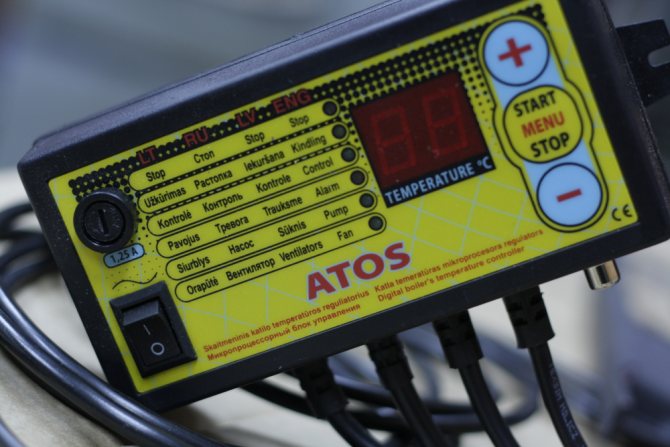

How to calculate power
Boiler power is measured in kilowatts, usually 1 kW is enough to heat 10 m² of house area. If the premises are not insulated or are located in harsh climatic zones, the stock should be 20-30% of the minimum.
It should be noted that it is not worth purchasing a boiler with a large margin, since a constantly low load can lead to its failure. This mainly applies to foreign models equipped with automation.
If the ceiling height in the house is more than 2.7 meters, additional calculations are required. This is done quite simply: calculate the coefficient of difference between the minimum ceiling and the real one, and multiply it by the power, based on the area of the room.
For example, if the ceiling is 3.0 m and the area of the room is 100 m²: 3 m / 2.7 m * 10 kW = 11 kW.
It is also necessary to take into account climatic features.
Climatic zone coefficients:
- 1.5-2 for the northern regions;
- 1.0-1.2 for the middle band;
- 0.7-0.9 for the southern regions.
In the presence of a second circuit, 20-25% is added, and it is also necessary to add a margin for peak cold temperatures - 10%.
Prices for the Wiessmann Vitoligno 100-S boiler
Wiessmann Vitoligno 100-S
Thus, the power of 11 kW must be increased first by 25%, and then by another 10%: (11 kW * 25%) * 10% = 15 kW.
For an accurate calculation, it is necessary to take the value of the possible heat loss of the building, as well as the safety factor. The product of these two indicators will be the calculated power of the boiler.You can determine the real heat loss by using a thermal imager: for this, it is advisable to contact a specialized organization.
Of the important factors that can affect heat loss, one can single out the presence of windows and their total area, number of storeys, as well as the thickness and material of the masonry.
On the sellers' sites, there is a power calculation calculator that can be used to confirm the calculations.






